Ipomoea aquatica
| Ipomoea aquatica | |
|---|---|

| |
| Scientific classification | |
| Kingdom: | Plantae |
| Clade: | Tracheophytes |
| Clade: | Angiosperms |
| Clade: | Eudicots |
| Clade: | Asterids |
| Order: | Solanales |
| Family: | Convolvulaceae |
| Genus: | Ipomoea |
| Species: | I. aquatica
|
| Binomial name | |
| Ipomoea aquatica | |
Ipomoea aquatica is a semi-aquatic, tropical plant grown as a vegetable for its tender shoots. This plant is known in English as water spinach, river spinach, water morning glory, water convolvulus, or by the more ambiguous names Chinese spinach, Chinese watercress, Chinese convolvulus or swamp cabbage, or kangkong in Southeast Asia and ong choy in Cantonese.[2][3] Its place of origin is not known.
Description[]
Ipomoea aquatica grows in water or on moist soil. Its stems are 2–3 metres (7–10 ft) or longer, rooting at the nodes, and they are hollow and can float. The leaves vary from typically sagittate (arrow head-shaped) to lanceolate, 5–15 cm (2–6 in) long and 2–8 cm (0.8–3 in) broad. The flowers are trumpet-shaped, 3–5 cm (1–2 in) in diameter, and usually white in colour with a mauve centre. Propagation is either by planting cuttings of the stem shoots, which will root along nodes, or by planting the seeds from flowers that produce seed pods.[4][5]
Origin[]
The origin of I. aquatica is not quite clear, but it is agreed that it is native to Southeast Asia.[6] Within Asia, several sources cite China as the location of the plant's domestication.[7][8][9][6] On the other hand, India has been suggested as the location of the plant's origin.[10][11][12] However, none of these sources give references other than when the name of I. aquatica first appeared in historical documents.[13] There are also studies suggesting that the species is native to Africa,[14][15] and it is debated whether it is part of African indigenous flora or whether it was introduced there by Chinese mariner Zheng He.[16]
Cultivation[]
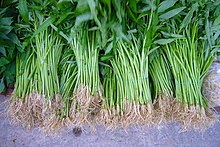
Ipomoea aquatica is most commonly grown in east, south, and southeast Asia. It flourishes naturally in waterways, and requires little if any care. It is used extensively in Indonesian, Burmese, Thai, Lao, Cambodian, Malay, Vietnamese, Filipino, and Chinese cuisine, especially in rural or kampung (village) areas. The vegetable is also extremely popular in Taiwan, where it grows well. During the Japanese occupation of Singapore in World War II, the vegetable grew remarkably easily in many areas, and became a popular wartime crop.
Water spinach has been found to be cultivated in the following countries:[17] [18]
In the United States it is cultivated in California, Florida, Hawaii, Texas, and the U.S. Virgin Islands.[19] It is also considered native to Africa[13] and in its wild form, for example, is collected and used by the Sambaa people in Tanzania.[20]
Water spinach is also potentially suitable for cultivation in greenhouses in more temperate regions.[21]
In non-tropical areas, it is easily grown in containers given enough water in a bright sunny location. It readily roots from cuttings.[citation needed]
Requirements for climate and soil[]
Water spinach is ideal for sub-tropical and tropical climate, as it does not grow well below 23.9 °C and is sensitive to frost. High soil moisture is beneficial for the growth. Clay soils and marshy soils rich in organic matter are suitable for water spinach. The ideal pH range for the growth is from 5 to 7. The provision of shade has been shown to have a positive influence on the yield of water spinach.[22]
Traditional way of cultivation[]
Water spinach is cultivated in a variety of systems. In Hong Kong, two methods are traditionally used: the dryland method and the wetland method.
In the dryland method, water spinach is grown on raised beds which are separated by irrigation ditches. The seeds can be sown directly onto the beds. Alternatively, a nursery may be used and the seedlings are transplanted when they reach a sufficient size. In either case, the distance between the plants should be about 12 cm by the time they are 15 cm tall. Regular irrigation is crucial in the dryland system and so is a sufficient fertilization. Water spinach cultivated with the dryland method is ready for harvest 50 to 60 days after sowing. Harvesting is being done by pulling up the whole plant.[23]
The wetland method is the traditionally more common and important method for cultivation in Hong Kong: In the wetland method, water spinach is cultivated on flat fields surrounded by raised banks, which have oftentimes been used as rice paddies in the past. These former rice paddies have a heavy clay soil with an iron-pan. This helps to retain water for the water spinach. The seedlings to be used in this methods are usually grown in a nursery on a dry field, as the germination under water is quite poor. Six weeks after sowing the seedlings, cuttings for transplantation can be taken from them. One cutting is an approximately 30 cm long cut from the stem containing seven or eight nodes. This is then planted in the field with a spacing of about 40 cm. The field is beforehand prepared by flooding it to a depth of 3 to 5 cm. The soil itself is tramped into a liquid mud so that the cuttings can root easily. Once the plants are established, the depth of the flooding is increased to 15 to 20 cm. The first harvest in the wetland method can usually be done at around 30 days after the transplantation. Also, the harvesting differs from the dryland system: In the wetland, the upper part of the main shoot is cut at about water level. This stimulates lateral growth and produces horizontal shoots carrying vertical branches. After the first harvests, every seven to ten days throughout the summer, these vertical branches can be harvested. After the planting period, the fields are drained and once the fruit of the water spinach is ripe, it is harvested, dried, then trodden to release the seeds which are to be used for the following season.[24]
Use of fertilizer[]
How much fertilizer is used for the cultivation strongly depends on the region. Most research is from the '80s and '90s. Generally, it has been shown that a dose of 60 kg N/ha is sufficient and that the application of K can be beneficial on the yield. Also, the application of plant growth regulators, for example Adenine and Zetanine, has been found to be an effective means to promote water spinach growth. One study has determined, that the highest yields are produced with the application of 60 kg/ha of N, 90 kg/ha of P2O5 and 50 kg/ha of K2O for the first harvest. For the second harvest the optimal fertilization was determined as 120 kg/ha of N, 45 kg/ha of P2O5 and 100 kg/ha of K2O.[25]
Taiwan: In Taiwan the usual fertilization includes the basic application of about 10 t/ha of cowdung followed by 50 kg/ha of ammonium sulfate after each harvest.[26]
Bangkok: In Bangkok it is common to apply about 300 kg/ha of NPK fertilizer twice a month.[27]
Indonesia: In Indonesia, usually 150 kg to 300 kg of NPK are applied per hectare.[28]
Pathogens and pests[]
There are several pathogens and pests reported, affecting I. aquatica. Pythium causes problems like damping-off, Cercospora leaf spot and root nematodes.[10] Also, aphids may be problems in fields. Additionally, there are several polyphagous insects feeding on I. aquatica. Lepidoptera species include Diacrisia strigatula Walker and Spodoptera litura. The “woolly-bear” caterpillars (D. virginica [Fabricius]) of the eastern United States and Diacrisia strigatula (Chinese tiger moth) are other species with wide food preferences.[29] A specialist pathogen on I. aquatica is the oomycete Albugo ipomoeae-aquaticae, though its range is restricted to southern and southeast Asia.[13]
Invasiveness[]
Ipomoea aquatica is listed by the USDA as a noxious weed,[30] especially in the states of Florida, California, and Hawaii, where it can be observed growing in the wild.[31] In the US, water spinach has mainly become a problem in Florida; why is unclear although the fast growth rate has been cited as a threat to native plants in certain areas of Florida.[32] It could be owing to the time since introduction, or owing to climatic factors.[33] I. aquatica has been extensively cultivated in Texas for over 30 years, having been originally brought there by Asian immigrants. Because no evidence indicates the plant has escaped into the wild, Texas lifted its ban on cultivation for personal use with no restrictions or requirements, noting its importance as a vegetable in many cultures, and also began permitting cultivation for commercial sales with the requirement of an exotic species permit.[34] Possession of I. aquatica has been prohibited in Florida since 1973, but it is still being grown and sold illegally. Some of the infestations in Florida public lakes have been eradicated, or at least attempts have been made.[35] In Sri Lanka it invades wetlands, where its long, floating stems form dense mats which can block the flow of water and prevent the passage of boats.[36]
Culinary uses[]
| Nutritional value per 100 g (3.5 oz) | |
|---|---|
| Energy | 79 kJ (19 kcal) |
3.14 g | |
| Dietary fiber | 2.1 g |
0.2 g | |
2.6 g | |
| Vitamins | Quantity %DV† |
| Vitamin A equiv. | 39% 315 μg |
| Thiamine (B1) | 3% 0.03 mg |
| Riboflavin (B2) | 8% 0.1 mg |
| Niacin (B3) | 6% 0.9 mg |
| Pantothenic acid (B5) | 3% 0.141 mg |
| Vitamin B6 | 7% 0.096 mg |
| Folate (B9) | 14% 57 μg |
| Vitamin C | 66% 55 mg |
| Minerals | Quantity %DV† |
| Calcium | 8% 77 mg |
| Iron | 13% 1.67 mg |
| Magnesium | 20% 71 mg |
| Manganese | 8% 0.16 mg |
| Phosphorus | 6% 39 mg |
| Potassium | 7% 312 mg |
| Sodium | 8% 113 mg |
| Zinc | 2% 0.18 mg |
| |
| †Percentages are roughly approximated using US recommendations for adults. Source: USDA FoodData Central | |
The vegetable is a common ingredient in East, South and Southeast Asian dishes, such as in stir-fried water spinach.[37] In Singapore, Indonesia, and Malaysia, the tender shoots along with the leaves are usually stir-fried with chili pepper, garlic, ginger, dried shrimp paste (belacan/terasi) and other spices. In Penang and Ipoh, it is cooked with cuttlefish and a sweet and spicy sauce. Also known as eng chhai in the Hokkien dialect, it can also be boiled with preserved cuttlefish, then rinsed and mixed with spicy rojak paste to become jiu hu eng chhai. Boiled eng chhai also can be served with fermented krill noodle belacan bihun and prawn mi.[38]
In Indonesian cuisine it is called kangkung, boiled or blanched together with other vegetables it forms the ingredient of gado-gado or pecel salads in peanut sauce. Some recipes that use kangkung is plecing kangkung from Lombok, and mie kangkung (kangkong noodle) from Jakarta.
In Thailand, where it is called phak bung (Thai: ผักบุ้ง), it is eaten raw, often along with green papaya salad or nam phrik, in stir-fries and in curries such as kaeng som.[39]
In the Philippines, where it is called kangkóng, the tender shoots are cut into segments and cooked, together with the leaves, in fish and meat stews, such as sinigang. The vegetable is also commonly eaten alone. In adobong kangkóng (also called apan-apan), it is sautéed in cooking oil, onions, garlic, vinegar, and soy sauce.[40] In ensaladang kangkóng (or kinilaw na kangkóng), it is blanched and served in vinegar or calamansi juice and fresh tomatoes and onions with salt and pepper to taste.[41][42] In binagoongang kangkóng (or ginisang kangkóng), it is sautéed with garlic and topped with bagoong alamang (shrimp paste) or bagoong isda (fermented fish) and sliced fresh tomatoes and onions, commonly also with cubed crispy liempo (pork belly) or pork adobo. It can also be spiced with siling haba or siling labuyo peppers, soy sauce, black pepper, and sugar. It differs from adobong kangkóng in that it does not use vinegar.[43][44][45][46] A local appetiser called crispy kangkóng has the leaves coated in a flour-based batter and fried until crisp, similar to Japanese vegetable tempura.[47][48]
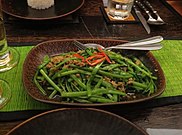
Cambodian chha trokuon
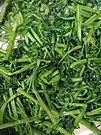
Chinese kōngxīncài
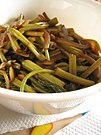
Filipino adobong kangkóng

Filipino ensaladang kangkóng
Indonesian plecing kangkung from Lombok
Indonesian mie kangkung (with noodles)

Malaysian-style kangkung belacan

Thai pak boong fai daeng

Vietnamese canh chua
Other uses[]
Phytoremediation[]
Using aquatic macrophytes to remove nutrients from wastewater and to control freshwater eutrophication has been reported to be a feasible way of phytoremediation. Various plants, including I. aquatica, have been tested for this use. Owing to its being edible and thus marketable, it could be an attractive option for this use.[49]
Animal feed[]
Water spinach is fed to livestock as green fodder with high nutritive value—especially the leaves, for they are a good source of carotene. It is fed to cattle, pigs, fish, ducks, and chicken.[50] Moreover, it is mentioned that in limited quantities, I. aquatica can have a somewhat laxative effect.[13]
Health effects[]
Medicinal use[]
I. aquatica is used in the traditional medicine of southeast Asia and in the traditional medicine of some countries in Africa. In southeast Asian medicine it is used against piles, and nosebleeds, as an anthelmintic, and to treat high blood pressure. In Ayurveda, leaf extracts are used against jaundice and nervous debility.[51] In indigenous medicine in Sri Lanka, water spinach is supposed to have insulin-like properties. Water extracts of I. aquatica showed a blood sugar-lowering effect in Wistar rats. An aqueous juice of 100g plant material was given 30 minutes before eating glucose to diabetes 2 patients. After two hours it could be observed that blood glucose peak level was reduced by around 30%.[52]
Also antioxidant bioactive compounds and anti-microbial substances could be detected in water spinach.[53] Furthermore, plant extracts of water spinach inhibit cancer cell growth of Vero, Hep-2 and A-549 cells, though have moderate anti-cancer activity.[51]
Health risk[]
Many of the waters where water spinach grows are fed by domestic or other waste. Pigs in southeast Asia are a natural reservoir for the parasite Fasciolopsis buski. Infections in the Mekong regions resulted from feeding on water spinach. Infections of F. buski in humans through water spinach can be anticipated. The infection can be prevented by proper preparation such as frying or boiling.[54] Contamination with thermotolerant coliforms (ThC) or protozoan bacteria with fecal origin, are very likely when the water spinach is planted in wastewater fed urban systems.[55] Water spinach has great potential as a purifier of aquatic habitats. It is an efficient accumulator of cadmium, lead, and mercury. This characteristic can be dangerous if water spinach is planted for human or animal feed in polluted aquatic systems. Mercury in water spinach is composed mostly as methylmercury and has the highest potential of becoming a threat to human health. The edible parts of the plant have a lower heavy metal concentration. The stems and bottom of the edible portion of the plant are higher in concentration and should be removed to minimize the heavy metal intake.[56][57]
Gallery[]

Ipomoea aquatica-habit in wetland-Ukumehame-Maui

Immature seeds of Ipomoea aquatica
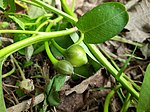
Immature seeds of Ipomoea aquatica

Flowers at Ukumehame, Maui, Hawaii
Picking Ipomoea aquatica

Flower of Ipomoea aquatica on water surface

Pak boong plants at Nakhonsawan school, Nakhon Sawan, Thailand

Seeds of Ipomoea aquatica

Flowers of Ipomoea aquatica

Ipomoea aquatica with flowers
Ipomoea aquatica

Asian-styled stir fry ipomoea aquatica served in chili and sambal

Ipomoea aquatica

Flower of Ipomoea aquatica in Bangladesh

Flower of Ipomoea aquatica in Bangladesh
See also[]
- Stir-fried water spinach
- List of vegetables
References[]
- ^ Gupta, A.K. (2013). "Ipomoea aquatica". IUCN Red List of Threatened Species. 2013: e.T168908A1252058. doi:10.2305/IUCN.UK.2013-1.RLTS.T168908A1252058.en.
- ^ "Kangkong / Ipomoea aquatica Forsk./ POTATO VINE / Herbal Medicinal Therapies / Philippine Alternative Medicine". Stuartxchange.org. Retrieved 13 January 2014.
- ^ "Chinese water spinach, or kangkong - eaten across Asia, a weed in the US". 13 November 2019. Retrieved 19 May 2020.
- ^ "Growing kangkong in water". curiousgardener.com.
- ^ "Kangkungking.com". Kangkungking.com. Archived from the original on 20 November 2012. Retrieved 13 January 2014.
- ^ Jump up to: a b Li, H.-L. 1970. The origin of cultivated plants in Southeast Asia. Economic Botany 24:3-19.
- ^ Purseglove, J.W. 1968. Tropical Crops. Dicotyledons 1. Longmans, Green and Co. Ltd., London.
- ^ Filatenko, A.A., K. Pistrick, H. Knüpffer & K. Hammer. 2003. E.N. Sinskaya’s inventory of plant taxa in the basic and dependent areas of the historical development of the flora of cultivated plants. Pp. 222-256 in Rudolf Mansfeld and Plant Genetic Resources. Proceedings of a Symposium dedicated to the 100th Birthday of Rudolf Mansfeld, Gatersleben, Germany, 8-9 October 2001. Edited by H. Knüpffer & J. Ochsmann. Schriften zu Genetischen Res- sourcen, Band 22, Zentralstelle für Agrardokumnetation und Information (ZADI), Informationszentrum Biologische Vielfait (IBV), Bonn, Germany.
- ^ Chang, K-C. 1970. Beginnings of agriculture in the Far East. Antiquity 44:1-12.
- ^ Jump up to: a b Westphal, E. 1993. Ipomoea aquatica Forsskal Pp. 181- 184 in Plant Resources in South-East Asia. Number 8. Vegetables. Edited by J.S. Siemonsma & K. Piluek. Pu-doc Scientific Publishers, Wageningen.
- ^ Owens, G. 2003. Kangkong Fact Sheet. www.nt.gov.au/ dpifm.
- ^ Van Wyk, B.-E. 2005. Food Plants of the World. An Illustrated Guide. Timber Press, Inc., Portland, Oregon.
- ^ Jump up to: a b c d Austin, Daniel F. F. "Water Spinach (Ipomoea Aquatica, Convolvulaceae) a Food Gone Wild." Ethnobotany Research and Applications 5 (2007): 123-46. Web.
- ^ Mbida, C., E. De Langhe, I. Vrydaghs, H. Doutrelepont, R. Swennen, W. Van Neer & P. de Maret. 2006. Phytolth evidence for the early presence of domesticated banana (Musa) in Africa. Pp. 68-81 in Documenting Domestication. New Genetic and Archaeological Paradigms. edited by M.A. Zeder, D.G. Bradley, E. Emshwiller & B.D. Smith. University of California Press, Berkeley.
- ^ Rossel, G. 1998. Taxonomic-Linguistic Study of Plantain in Africa. CNWS Publications, Leiden.
- ^ Lee, S.L. 2002. Chinese mariner Zheng He [Cheng Ho]. www.chinapage.com/history/zhenghe2.html.
- ^ Austin, Daniel F. F. "Water Spinach (Ipomoea Aquatica, Convolvulaceae) a Food Gone Wild." Ethnobotany Research and Applications 5 (2007): 123-46. Web.
- ^ Pinker, I., U. Bubner, and M. Böhme. "Selection of water spinach (Ipomoea aquatica Forssk.)-genotypes for protected cultivation in temperate regions." I International Conference on Indigenous Vegetables and Legumes. Prospectus for Fighting Poverty, Hunger and Malnutrition 752. 2006.
- ^ Chilton, Earl W. "Risk Assessment for Water Spinach (Ipomoea Aquatica) in Texas." Journal Of Aquatic Plant Management 55 (2017): 96-102. Web.
- ^ Vainio-Mattila, Katariina. "Wild vegetables used by the Sambaa in the Usambara Mountains, NE Tanzania." Annales Botanici Fennici. Finnish Zoological and Botanical Publishing Board, 2000.
- ^ Pinker, I., U. Bubner, and M. Böhme. "Selection of water spinach (Ipomoea aquatica Forssk.)-genotypes for protected cultivation in temperate regions." I International Conference on Indigenous Vegetables and Legumes. Prospectus for Fighting Poverty, Hunger and Malnutrition 752. 2006.
- ^ Pandey, A.K. Aquatic Vegetables. Udaipur: Agrotech Academy, 2011. Print.
- ^ Edie, Harry, and H. Ho. "Ipomoea Aquatica as a Vegetable Crop in Hong Kong." Economic Botany 23.1 (1969): 32-36. Web.
- ^ Edie, Harry, and H. Ho. "Ipomoea Aquatica as a Vegetable Crop in Hong Kong." Economic Botany 23.1 (1969): 32-36. Web.
- ^ Pandey, A.K. Aquatic Vegetables. Udaipur: Agrotech Academy, 2011. Print.
- ^ Pandey, A.K. Aquatic Vegetables. Udaipur: Agrotech Academy, 2011. Print.
- ^ Pandey, A.K. Aquatic Vegetables. Udaipur: Agrotech Academy, 2011. Print.
- ^ Pandey, A.K. Aquatic Vegetables. Udaipur: Agrotech Academy, 2011. Print.
- ^ Austin, Daniel F. (2004). Florida Ethnobotany. CRC Press. p. 365. ISBN 978-0-8493-2332-4.
- ^ "Federal Noxious Weed List". USDA. Retrieved 13 August 2019.
- ^ "Ipomoea aquatica Forssk. swamp morning-glory". plants.usda.gov. United States Department of Agriculture Natural Resources Conservation Service. Retrieved 10 July 2015.
- ^ "Water Spinach". Florida Fish And Wildlife Conservation Commission. Retrieved 11 May 2020.
- ^ Edie, Harry, and H. Ho. "Ipomoea Aquatica as a Vegetable Crop in Hong Kong." Economic Botany 23.1 (1969): 32-36. Web.
- ^ "Texas Invasives". texasinvasives.org.
- ^ Langeland, K.A. & K.C. Burks. 1998. Editors of Identification & Biology of Non-Native Plants in Florida's Natural Areas. University of Florida, Gainesville
- ^ Gunasekera Lalith. Invasive Plants, A Guide to the Identification of the Most Invasive Plants in Sri Lanka, Colombo 2009.
- ^ "Water spinach and coconut stir-fry (kankun mallung)". SBS Food.
- ^ "Archived copy". Archived from the original on 17 June 2015. Retrieved 20 April 2012.CS1 maint: archived copy as title (link)
- ^ "Nutritional composition of traditional Thai foods used local vegetables" (PDF). Archived from the original on 12 December 2012. Retrieved 4 April 2017.CS1 maint: bot: original URL status unknown (link)
- ^ Piccio, Belle. "Apan-apan: The Dish Reflective of the Tradition of Ilonggo Farmers". Choose Philippines. Retrieved 11 January 2019.
- ^ "Ensaladang Kangkong". Mely's Kitchen. Retrieved 11 January 2019.
- ^ "Ensaladang Kangkong". Overseas Pinoy Cooking. Retrieved 11 January 2019.
- ^ "Binagoongang Kangkong". Pinoy Hapagkainan. Retrieved 11 January 2019.
- ^ "Spicy Stir-Fry Kangkong with Bagoong". Pinoy Kitchenette. Retrieved 11 January 2019.
- ^ "Kangkong with Bagoong". Filpino Style Recipe. Retrieved 11 January 2019.
- ^ "Kangkong with Bagoong Recipe". Panlasang Pinoy. Retrieved 11 January 2019.
- ^ "Crispy Kangkong Recipe (River Spinach) - Filipino Recipes Portal". Pinoyrecipe.net. Retrieved 13 January 2014.
- ^ "Crispy Spinach Recipe". Panlasang Pinoy. Retrieved 11 January 2019.
- ^ Li, M., Wu, Y. J., Yu, Z. L., Sheng, G. P., & Yu, H. Q. (2007). Nitrogen removal from eutrophic water by floating-bed-grown water spinach (Ipomoea aquatica Forsk.) with ion implantation. Water research, 41(14), 3152-3158.
- ^ Pandey, A.K. Aquatic Vegetables. Udaipur: Agrotech Academy, 2011. Print.
- ^ Jump up to: a b Nagendra Prasad, K.; Shivamurthy, G.R.; Aradhya, S.M. (2008). "Ipomoea aquatica, An Underutilized Green Leafy Vegetable: A Review". International Journal of Botany. 1 (4): 127.
- ^ Wiart, Christophe (2018). Medicinal plants in Asia for metabolic syndrome : natural products and molecular basis. Boca Raton: CRC Press. p. 44. ISBN 978-1-315-17775-5.
- ^ Anbu Jothi, B.; Geetha, B. (May 2017). "GC-MS and FT-IR analysis of bioactive compounds on methanol extract of Ipomoea aquatica". International Journal of Fisheries and Aquatic Research. 2 (3): 15.
- ^ Yoshihara, S., Hung, N. P., Hung, N. H., Loc, C. B. "Helminths and Helminthiosis of Pigs in the Mekong Delta, Vietnam with Special Reference to Ascariosis and Fasciolopsis buski Infection." Jarq 33, 193-199 (1999)
- ^ Vuong TA, Nguyen TT, Klank LT, Phung DC, Dalsgaard A."Faecal and protozoan parasite contamination of water spinach (Ipomoea aquatica) cultivated in urban wastewater in Phnom Penh, Cambodia." Tropical Medicine and International Health, 73-81 (2007)
- ^ Gosh, S. "Wetland Macrophytes as toxic metal accumulators" International Journal of Environmental Sciences, 523-528 (2010)
- ^ Göthberg A., Greger, M., Bengtsson, E. "Accumulation of heavy metals in water spinach (Ipomoea aquatica) cultivated in the Bangkok region, Thailand" Environmental Toxicology, 1934-1939 (2009)
External links[]
| Wikimedia Commons has media related to Ipomoea aquatica. |
| Wikispecies has information related to Ipomoea aquatica. |
- Germplasm Resources Information Network: Ipomoea aquatica
- " Multilingual taxonomic information". University of Melbourne.
- Water spinach nutritional information from Kasetsart University
- Center for Aquatic, Wetland and Invasive Plants, University of Florida
- USDA Federal Noxious Weed Regulations (Possession in USA requires permit)
- Species Profile - Water Spinach (Ipomoea aquatica), National Invasive Species Information Center, United States National Agricultural Library. Lists general information and resources for water spinach.
- IUCN Red List least concern species
- Ipomoea
- Invasive plant species in Sri Lanka
- Leaf vegetables
- Perennial vegetables
- Plants described in 1775
- Asian vegetables
























